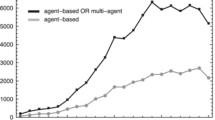Abstract
When developing a model for an Agent-Based Simulation (ABS) it is very important to select the update-strategy which reflects the semantics of the model as simulation results can vary vastly across different update-strategies. This awareness, we claim, is still underdeveloped in the majority of the field of ABS. In this paper we propose a new terminology to classify update strategies and then identify different strategies using this terminology. This will allow implementers and researchers in this field to use a general terminology, removing ambiguities when discussing ABS and their models. We will give results of simulating a discrete and a continuous game using our update-strategies and show that in the case of the discrete game only one specific strategy seems to be able to produce its emergent patterns, whereas the pattern of the continuous game seems to be robust under varying update-strategies.
Access this chapter
Tax calculation will be finalised at checkout
Purchases are for personal use only
Similar content being viewed by others
References
Bersini, H., & Detours, V. (1994). Asynchrony induces stability in cellular automata based models. In In proceedings of artificial life IV (pp. 382–387). Cambridge, MA: MIT Press.
Botta, N., Mandel, A., & Ionescu, C. (2010). Time in discrete agent-based models of socio-economic systems (Documents de travail du Cen-tre d’Economie de la Sorbonne No. 10076). Université Panthéon-Sorbonne (Paris 1), Centre d’Economie de la Sorbonne.
Clinger, W. D. (1981). Foundations of actor semantics (Tech. Rep.). Cambridge, MA: Massachusetts Institute of Technology.
Dawson, D., Siebers, P. O., & Vu, T. M. (2014, September). Opening Pandora’s box: Some insight into the inner workings of an Agent-Based Simulation environment. In 2014 Federated conference on computer science and information systems (pp. 1453–1460). https://doi.org/10.15439/2014F335.
Greif, I. (1975). Semantics of communicating parallel processes (Tech. Rep.). Cambridge, MA: Massachusetts Institute of Technology.
Hewitt, C., Bishop, P., & Steiger, R. (1973). A universal modular ACTOR formalism for artificial intelligence. In Proceedings of the 3rd international joint conference on artificial intelligence (pp. 235–245). San Francisco: Morgan Kaufmann Publishers Inc.
Huberman, B. A., & Glance, N. S. (1993, August). Evolutionary games and computer simulations. Proceedings of the National Academy of Sciences, 90(16), 7716–7718.
Jansen, M. (2012). Introduction to agent-based modeling. Retrieved from https://www.openabm.org/book/introduction-agent-based-modeling
Lysenko, M., D’souza, R., & Rahmani, K. (2008). A framework for megascale agent based model simulations on the GPU, Journal of Artificial Societies and Social Simulation (JASSS) 11(4):10. http://jasss.soc.surrey.ac.uk/11/4/10.html
Nowak, M. A., & May, R. M. (1992, October). Evolutionary games and spatial chaos. Nature, 359(6398), 826–829. https://doi.org/10.1038/359826a0.
Page, S. E. (1997, February). On incentives and up-dating in agent based models. Computational Economics, 10(1), 67–87. https://doi.org/10.1023/A:1008625524072.
Railsback, S., & Grimm, V. (2011). Agent-based and individual-based modeling: A practical introduction. Princeton, NJ/Oxford, UK: Princeton University Press.
Wilensky, U., & Rand, W. (2015). An introduction to agent-based modeling: Modeling natural, social, and engineered complex systems with NET-logo. Cambridge, MA/London, UK: MIT Press.
Wooldridge, M. (2009). An introduction to multiagent systems (2nd ed.). Hoboken, NJ: Wiley Publishing.
Yuxuan, J. (2016). The agent-based simulation environment in Java (Unpublished doctoral dissertation). University of Nottingham, School of Computer Science.
Author information
Authors and Affiliations
Corresponding author
Editor information
Editors and Affiliations
Rights and permissions
Copyright information
© 2019 Springer Nature Switzerland AG
About this chapter
Cite this chapter
Thaler, J., Siebers, PO. (2019). The Art of Iterating: Update-Strategies in Agent-Based Simulation. In: Payne, D., et al. Social Simulation for a Digital Society. SSC 2017. Springer Proceedings in Complexity. Springer, Cham. https://doi.org/10.1007/978-3-030-30298-6_3
Download citation
DOI: https://doi.org/10.1007/978-3-030-30298-6_3
Published:
Publisher Name: Springer, Cham
Print ISBN: 978-3-030-30297-9
Online ISBN: 978-3-030-30298-6
eBook Packages: Physics and AstronomyPhysics and Astronomy (R0)




